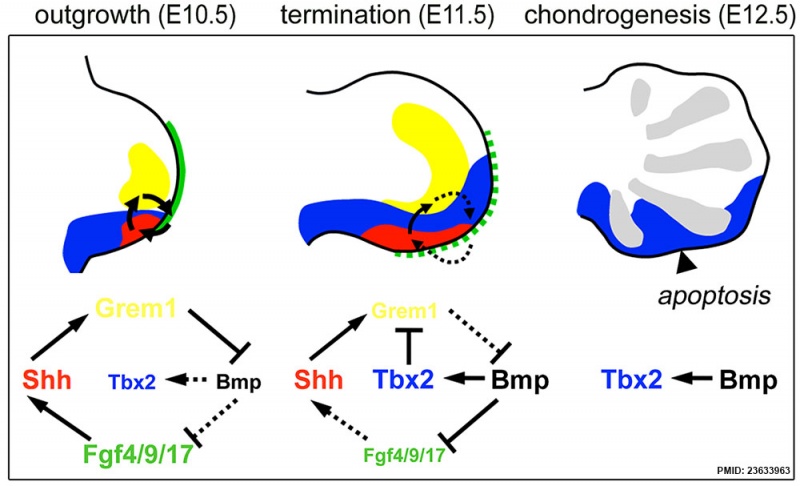File:Hindlimb Tbx2 model.jpg

Original file (1,000 × 607 pixels, file size: 84 KB, MIME type: image/jpeg)
Model of Tbx2 function in the posterior hindlimb mesenchyme
During normal limb bud outgrowth (E10.5) the expression domains of Shh (red), Grem1 (yellow) and Fgf4/9/17 (green) are in close proximity allowing propagation of the e-m signaling loop. Following proliferative expansion of ZPA-derived cells, a broadened Tbx2 expression (blue) causes Grem1 repression. Progressive displacement of Grem1-secreting cells from the AER terminates e-m signaling (E11.5, dotted arrows). The diagrams illustrate these dynamic signaling activities. Failure of Grem1 repression in Tbx2-deficient hindlimbs causes prolonged e-m signaling.
- Links: Limb Development | Tbx | Mouse Development
Reference
<pubmed>23633963</pubmed>| PLoS Genet.
Copyright
© 2013 Farin et al. This is an open-access article distributed under the terms of the Creative Commons Attribution License, which permits unrestricted use, distribution, and reproduction in any medium, provided the original author and source are credited.
Figure 7. doi:10.1371/journal.pgen.1003467.g007 Original figure cropped, adjusted in size and labelling.
File history
Click on a date/time to view the file as it appeared at that time.
| Date/Time | Thumbnail | Dimensions | User | Comment | |
|---|---|---|---|---|---|
| current | 10:48, 7 December 2014 |  | 1,000 × 607 (84 KB) | Z8600021 (talk | contribs) | ==Model of Tbx2 function in the posterior hindlimb mesenchyme== (A) During normal limb bud outgrowth (E10.5) the expression domains of Shh (red), Grem1 (yellow) and Fgf4/9/17 (green) are in close proximity allowing propagation of the e-m signaling loo... |
You cannot overwrite this file.
File usage
The following 2 pages use this file: